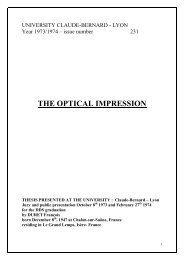english version(pg40to78) - Pr. François Duret
english version(pg40to78) - Pr. François Duret
english version(pg40to78) - Pr. François Duret
Create successful ePaper yourself
Turn your PDF publications into a flip-book with our unique Google optimized e-Paper software.
F <strong>Duret</strong> and Coll. <strong>Pr</strong>incipes de fonctionnement et applications techniques de l’empreinte optique dans l’exercice de cabinet<br />
(traduction Anglaise)<br />
Page 99<br />
for the realisation of a CAD/CAM creation software. The experience<br />
and creativity of the researchers are indispensable for the automated<br />
work and stating the contrary shows a misconception of both the<br />
CAD/CAM robotics principles and those of traditional prosthesis.<br />
What is left to worry about is the 3D handling on 2D objects. This<br />
remark, due to one of our greatly experienced colleagues in<br />
Strasbourg C BERNHEIM, makes us perplexed as it isn’t without any<br />
sense. It is inevitable that, if teaching doesn’t follow the scientific<br />
evolution, our future colleagues will only have a part of the necessary<br />
training and handling will be reserved to an elite. We have good hope<br />
though as the habit of working with plans is a thing which is taught<br />
easily to architecture students.<br />
Manufacturing<br />
DIGITAL COMMAND<br />
Indispensable piece to the command of a tool machine, the digital<br />
command is a kind of computer moving the axes, and so the tool to a<br />
precise position of the piece to be manufactured. The CAD/CAM<br />
software has created the crown in ordinated dimensions with Cartesian<br />
coordinates (X, Y, Z) at the intrados level as well as the extrados. For<br />
each number corresponds a tool position.<br />
The principle of the digital command can be this summarised: it is an<br />
automation process enabling the driving of a mobile mechanical organ<br />
to a position determined by an order. This position is obtained by<br />
moving linearly or angularly according to the mobile’s freedom<br />
degree (the order is delivered in digital, Cartesian or polar<br />
coordinates 28 ) (Fig. 35).<br />
Now of a mature age, the digital command has a number of very high<br />
basic functions and its implementation is simple and rational. The<br />
dental prosthesis being a simple unit piece but complex, it perfectly<br />
enters in the framework of studies on low production commands<br />
which were the object of numerous concluding tries between 1975 and<br />
1985.<br />
Today the high production cycle to which researchers are committed<br />
doesn’t interest us if<br />
Les Cahiers de <strong>Pr</strong>othèse (50) pp 73 – 110, 1985



